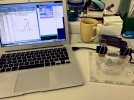- Joined
- Nov 19, 2014
- Messages
- 2,633
Just for fun, I have been trying to make a tester for edge performance.
I think I finally made something which might work.

Basically, it is a DIY version of Edge-on-up.
Fish line (0.28 mm) is placed in the slits in two corks and secured with clips.
The styrofoam is just a cushion to prevent the edge to hit the plastic.

I just but a blade on the fish line and push down until it cuts the line.
Since the scale I have does not register the max weight, I videotape the display to read it.
I have do a lot of testing to check the reproducibility and with thinner fish lines.
But so far I got quite consistent numbers with Feather Hi-Stainless razor.
I think I finally made something which might work.

Basically, it is a DIY version of Edge-on-up.
Fish line (0.28 mm) is placed in the slits in two corks and secured with clips.
The styrofoam is just a cushion to prevent the edge to hit the plastic.

I just but a blade on the fish line and push down until it cuts the line.
Since the scale I have does not register the max weight, I videotape the display to read it.
I have do a lot of testing to check the reproducibility and with thinner fish lines.
But so far I got quite consistent numbers with Feather Hi-Stainless razor.

 . And way too small for building a BESS scale. I am not going to build a diy sharpness tester, just saying.
. And way too small for building a BESS scale. I am not going to build a diy sharpness tester, just saying.




